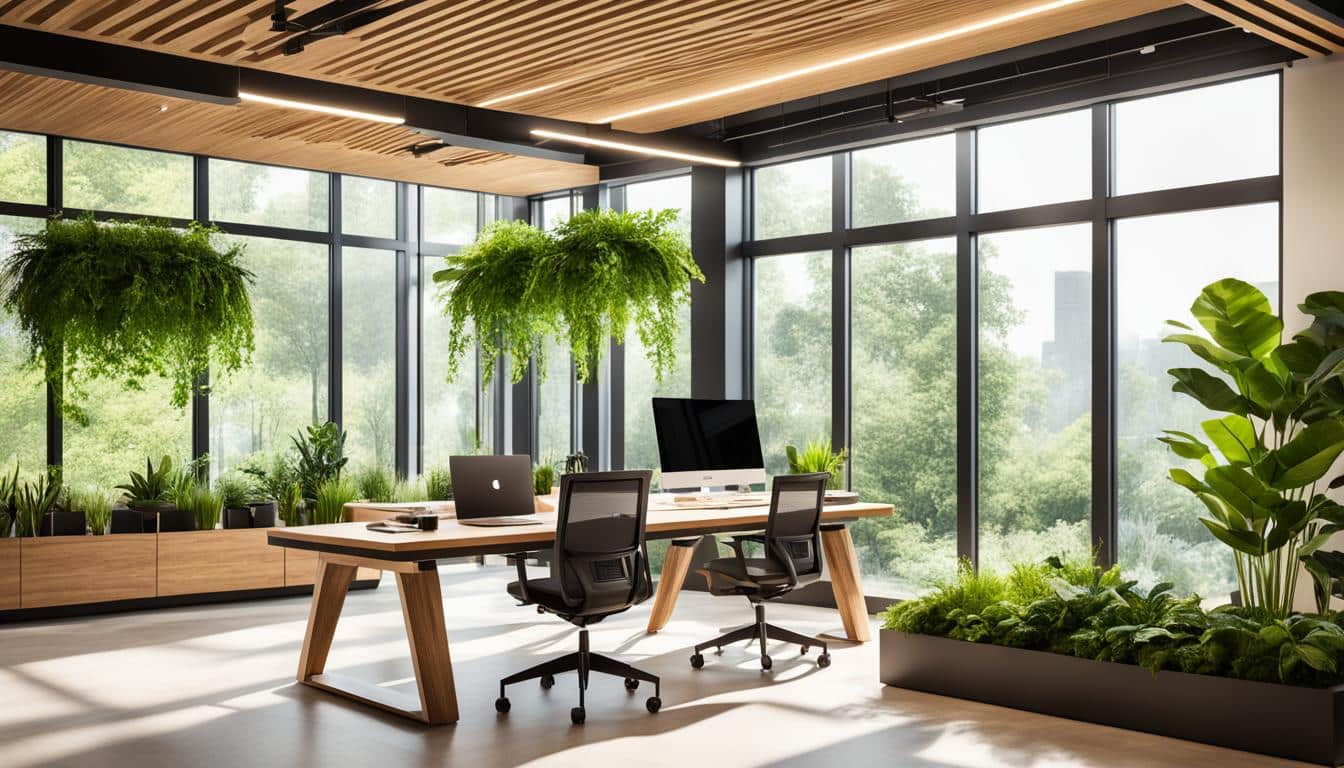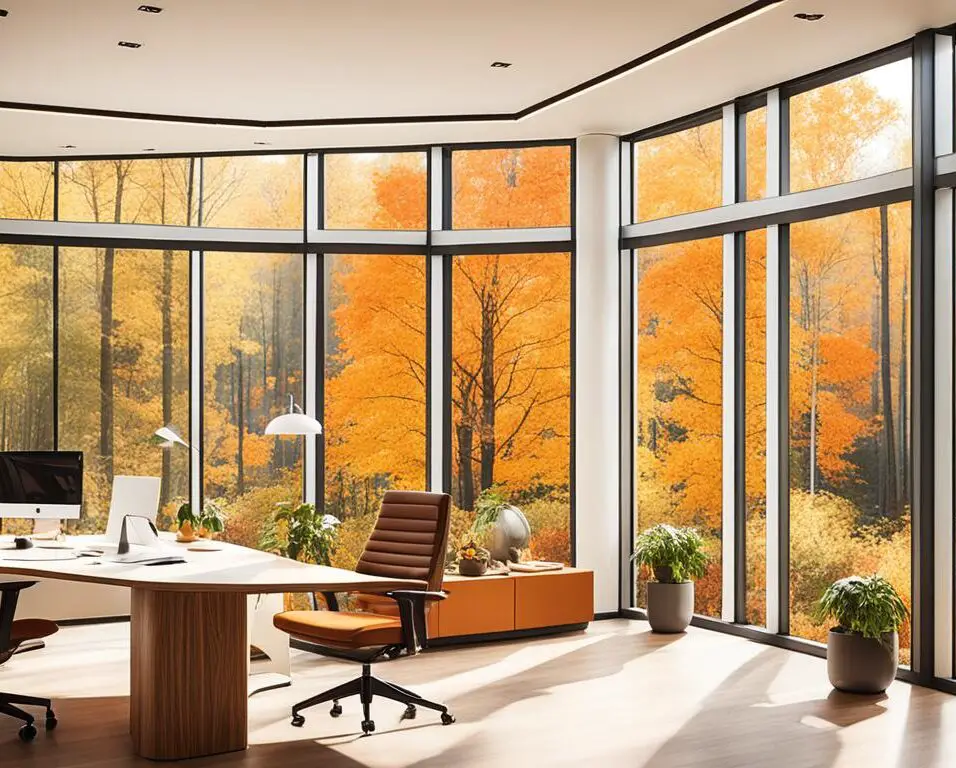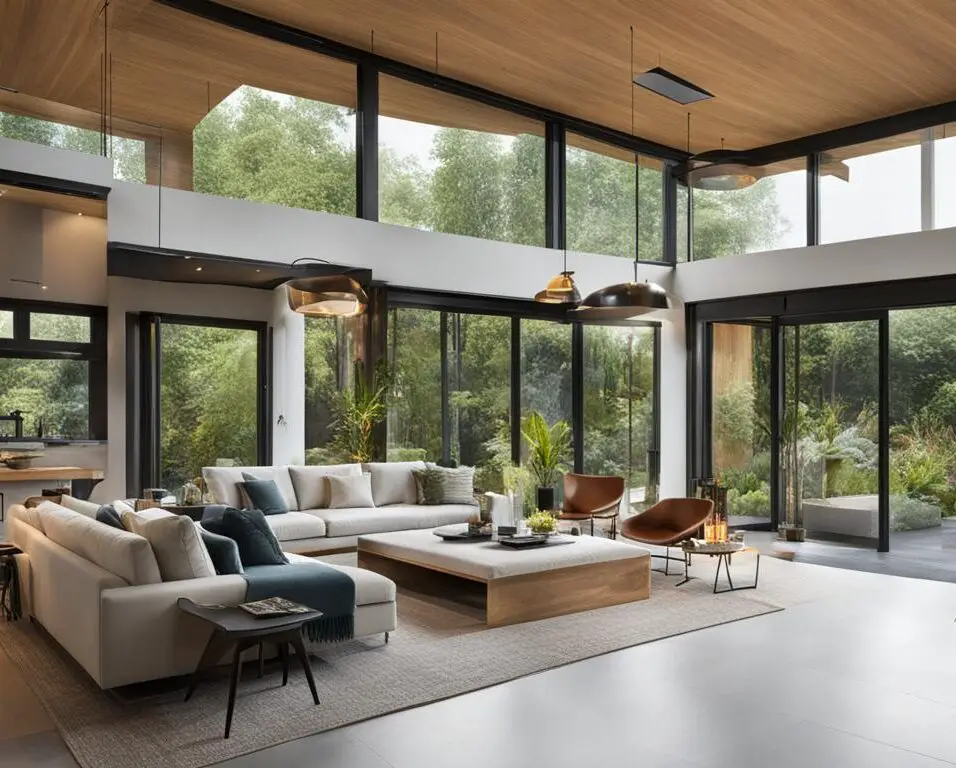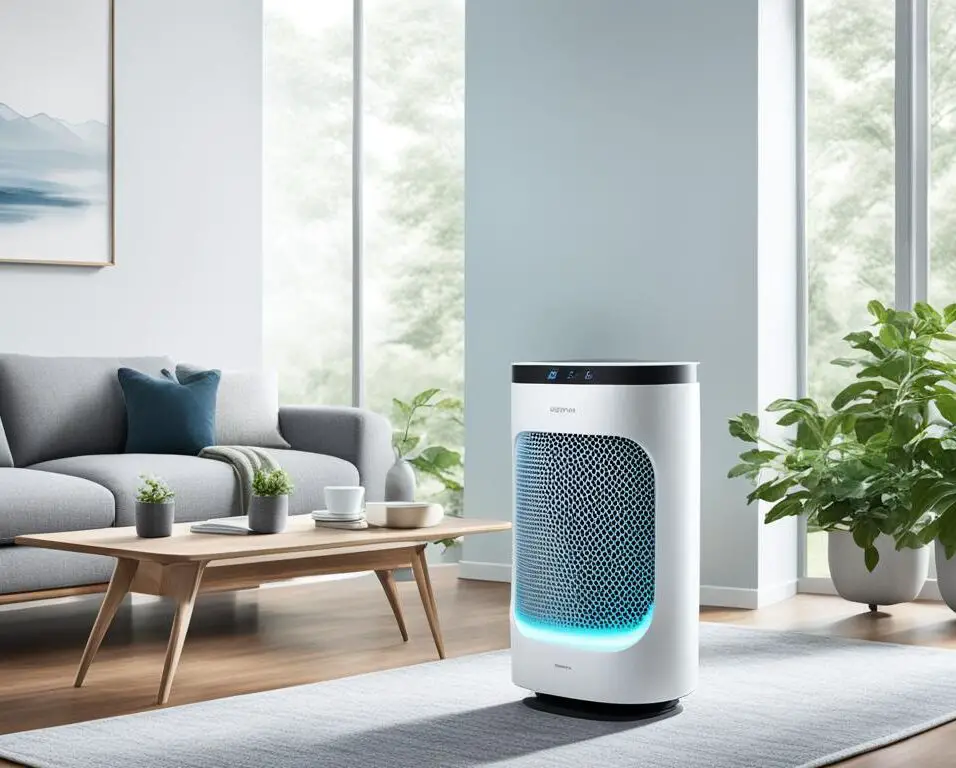Boosting Productivity with Biophilic Design in Workspaces
Welcome to the first section of our comprehensive guide on boosting productivity in workspaces through biophilic design. In today’s fast-paced and technology-driven world, creating a workspace that enhances productivity is paramount. One effective approach is incorporating biophilic design principles, which seamlessly blend nature into the built environment.
Biophilic design is a design approach that integrates natural elements such as plants, natural light, and natural materials into the workspace. Research has shown that this design strategy has a significant impact on improving productivity by creating a more visually appealing and soothing environment.
Studies have demonstrated that exposure to nature and natural elements in the workplace can enhance cognitive function, creativity, and overall well-being. By incorporating biophilic design principles, companies can reduce stress levels, increase employee satisfaction, and ultimately improve productivity.
Throughout this guide, we will explore various facets of biophilic design and how they can contribute to a more productive workspace. From ergonomic furniture and natural light to acoustic design and color psychology, we will delve into each aspect and its positive impact on productivity.
Key Takeaways:
- Biophilic design integrates natural elements into the workspace to boost productivity.
- Exposure to nature and natural elements enhances cognitive function and creativity.
- Biophilic design reduces stress levels and increases employee satisfaction.
- Ergonomic furniture, natural light, acoustic design, and color psychology are integral components of a productive workspace.
- Collecting user feedback plays a crucial role in optimizing workspace design.
The Benefits of Ergonomic Furniture in the Workspace
The choice of furniture in the workspace plays a crucial role in determining productivity. When employees are provided with ergonomic furniture, specifically designed to support their natural movement and posture, it can have a significant impact on their well-being and overall productivity.
Ergonomic furniture is engineered to reduce physical discomfort, fatigue, and the risk of injury that can arise from prolonged sitting or improper posture. By offering comfortable and adjustable chairs, desks, and other ergonomic solutions, companies create a workspace that promotes proper alignment and reduces strain on the body.
Employees who work in an ergonomically designed environment experience fewer aches, pains, and discomfort, allowing them to focus more effectively on their tasks. When employees are comfortable and supported, they can work for longer periods without experiencing fatigue or discomfort, resulting in increased productivity and efficiency.
To illustrate the benefits of ergonomic furniture in the workspace, consider the following table:
| Benefits of Ergonomic Furniture | Impact on Productivity |
|---|---|
| Reduces physical discomfort and fatigue | Increase in sustained focus and task completion |
| Promotes proper posture | Reduction in musculoskeletal disorders and related absences |
| Adjustable features accommodate diverse employee needs | Enhancement of individual comfort and satisfaction |
| Reduces the risk of injury | Decrease in workers’ compensation claims and associated costs |
As seen in the table, incorporating ergonomic furniture into the workspace leads to numerous positive outcomes, including increased focus, reduced absences due to musculoskeletal issues, improved employee satisfaction, and lower costs associated with injury claims.
By investing in ergonomic furniture, companies prioritize the well-being of their employees, creating an environment that supports their physical health and enhances overall productivity.
The Role of Natural Light in Enhancing Productivity
Natural light plays a vital role in promoting productivity in the workspace. Not only does it create a pleasant and inviting atmosphere, but exposure to natural light has also been shown to have several benefits for employee well-being and productivity.
Firstly, natural light has a positive impact on mood and energy levels. Studies have found that employees working in spaces with ample natural light experience improved mood and higher levels of alertness. This increased positivity and energy translate into enhanced productivity and a more engaged workforce.
Furthermore, natural light helps to enhance concentration. The presence of natural light stimulates the production of serotonin, a hormone that promotes focus and attentiveness. In contrast, artificial lighting can cause eye strain and fatigue, leading to decreased productivity over time.
To make the most of natural light in the workspace, it is important to incorporate design elements that maximize its benefits. Ample windows and skylights allow natural light to flood the space, creating a bright and airy environment. Transparent or translucent partitions can help distribute light evenly throughout the workspace, ensuring that all areas receive sufficient natural light.
“Natural light has a positive impact on mood and energy levels”
It is also important to avoid blocking light sources with furniture or curtains. This obstructs the flow of natural light and reduces its impact on the workspace. By allowing natural light to permeate the space, companies can create a more uplifting and vibrant atmosphere that fosters productivity.
In spaces with limited access to natural light, it may be necessary to supplement with artificial lighting. However, it is essential to select lighting that mimics the color temperature and intensity of daylight. This helps maintain a harmonious lighting environment and minimizes the negative effects of artificial lighting on productivity.
Overall, harnessing the power of natural light in the workspace can significantly enhance productivity. Its positive impact on mood, energy levels, and concentration makes it an invaluable design element. By incorporating ample natural light and optimizing the workspace to maximize its benefits, companies can create a vibrant and productive environment that nurtures their employees’ well-being and success.
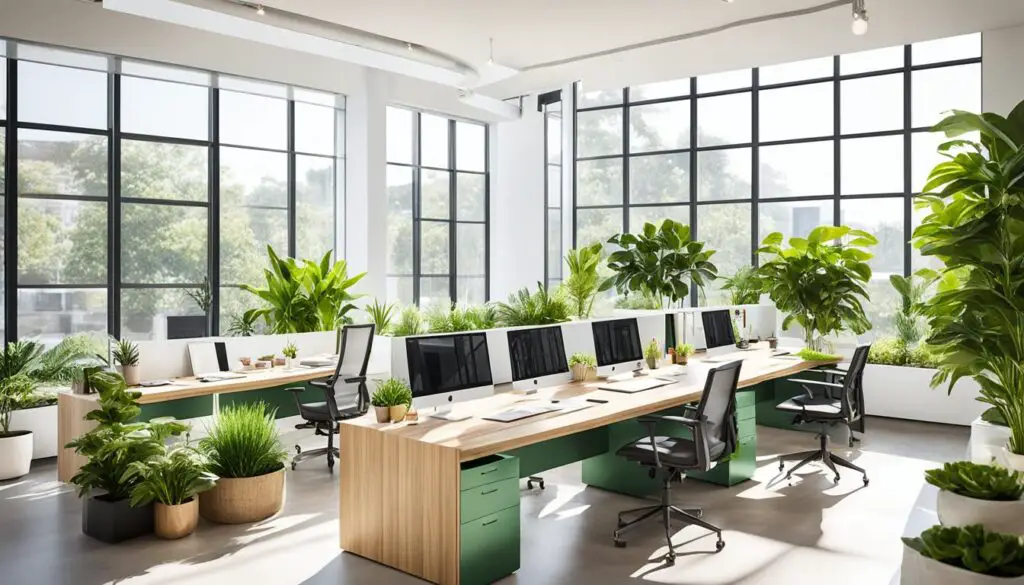
Key Points:
- Natural light promotes improved mood, increased energy levels, and enhanced concentration.
- Maximizing natural light in the workspace involves incorporating ample windows, transparent or translucent partitions, and avoiding obstruction of light sources.
- In spaces with limited natural light, supplementary artificial lighting should mimic the color temperature and intensity of daylight.
Creating a Calming and Distraction-Free Environment with Acoustic Design
Noise can have a significant impact on productivity in the workspace, causing distractions and increasing stress levels. That’s where acoustic design comes in. By employing various materials, shapes, and layouts that absorb, reflect, or diffuse sound waves, companies can create a more peaceful and comfortable sound environment.
One effective way to implement acoustic design is to incorporate acoustic panels throughout the workspace. These panels are designed to absorb sound and reduce echoes, effectively minimizing noise distractions. Additionally, carpets and curtains can help to dampen sound, especially in areas where foot traffic or outside noise is prevalent.
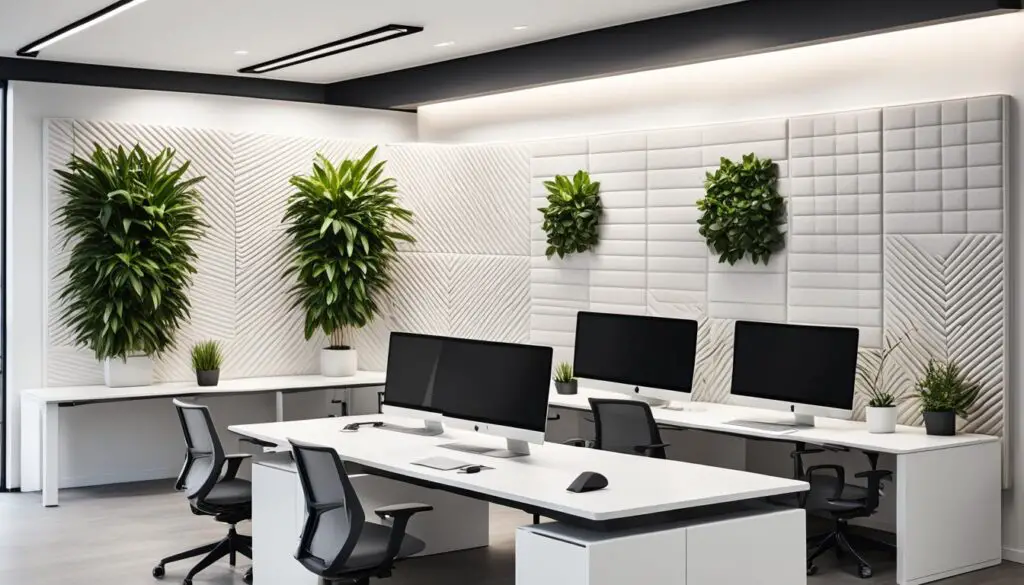
Another useful tool in creating a distraction-free environment is the use of white noise machines. These machines emit a constant, soothing sound that can help to drown out disruptive noises and create a more consistent sound environment.
Designating quiet areas for individual work and collaborative spaces for group work is another effective strategy in acoustic design. By having separate areas with controlled noise levels, employees can choose environments that suit their needs and preferences, allowing them to focus and be more productive.
H3: Benefits of Acoustic Design in the Workspace
- Reduces distractions and improves concentration
- Enhances overall workplace well-being and employee satisfaction
- Promotes better communication and collaboration
- Provides a sense of privacy and personal space
By implementing acoustic design principles, companies can create a workspace that is conducive to productivity and employee well-being. The controlled sound environment helps employees stay focused on their tasks, leading to increased productivity and job satisfaction.
The Psychology of Color and Its Impact on Productivity
Color plays a significant role in shaping our emotions and cognitive function. Each color has the power to evoke specific emotions and behaviors in individuals. For instance, blue is known to promote calmness and trust, while red can stimulate alertness and urgency. Understanding the psychology of color is crucial when selecting colors for the workspace.
When designing a workspace, it is essential to consider the goals, values, and identity of the organization, as well as the preferences and personalities of the employees. By strategically using colors to create contrast, harmony, or accent, it is possible to influence productivity and create a visually stimulating environment.
Different color schemes can be employed to differentiate between various areas or functions within the workspace. This not only enhances productivity but also creates a more dynamic and engaging atmosphere.
“Color is a powerful tool that can evoke specific emotions and behaviors. By harnessing the psychology of color, we can create workspaces that inspire and motivate employees, ultimately boosting productivity.”
For example, using warm colors like orange or yellow in collaborative spaces can foster creativity and energy, while cool colors like green or purple in quiet areas can promote focus and concentration. By carefully selecting the appropriate colors based on the desired outcome, organizations can design workspaces that align with their objectives and support the productivity of their employees.
It is worth noting that individual preferences for colors may vary. Therefore, it is beneficial to involve employees in the decision-making process and gather feedback to ensure a workspace that resonates with their needs and preferences.
Strategic Use of Color in the Workspace:
- Incorporate blue hues in areas where calmness and trust are important, such as meeting rooms or spaces dedicated to relaxation.
- Utilize red accents in areas where urgency and attention to detail are required, such as task-oriented workstations.
- Use green tones in areas where focus and productivity are critical, such as individual workstations or quiet rooms.
- Integrate warm colors like orange or yellow in collaborative spaces to stimulate creativity and foster a lively atmosphere.
- Experiment with color combinations that create contrast or harmony within the workspace, adding visual interest and facilitating productivity.
By understanding the psychology of color and harnessing its potential, organizations can transform their workspaces into environments that inspire, motivate, and enhance productivity.
The Importance of User Feedback in Workspace Design
Creating a workspace that supports productivity goes beyond aesthetics and functionality. It involves understanding the needs and preferences of the people who use the space: the employees. User feedback plays a crucial role in designing workspaces that truly enhance productivity and promote employee well-being.
When employees are actively involved in the design process, their voices are heard, and their opinions are valued. This inclusive approach creates a sense of ownership and fosters a positive work environment. By collecting user feedback, companies gain valuable insights into the specific needs, challenges, and priorities of their employees.
Surveys, interviews, focus groups, and observation are some effective methods to gather user feedback. These methods allow companies to gain a deeper understanding of how employees interact with their workspace and identify pain points or areas for improvement.
For example, a survey can provide employees with an opportunity to express their preferences regarding seating arrangements, lighting, noise levels, and the overall layout of the workspace. Interviews and focus groups can delve deeper into specific topics, allowing employees to elaborate on their experiences and suggest innovative ideas.
User feedback also promotes employee satisfaction and engagement with the workspace. When employees feel that their opinions matter and their needs are being addressed, they are more likely to feel valued and invested in their work environment. This, in turn, can boost morale and overall productivity.
Creating a feedback loop is essential for the continuous improvement of the workspace. Regularly monitoring and evaluating the effectiveness of design decisions allows companies to make data-driven adjustments or improvements. By taking into account the feedback received, companies can adapt the workspace to better meet the evolving needs of their employees and foster a productive and supportive environment.
Ultimately, user feedback is a vital tool in workspace design. By involving employees and listening to their insights, companies can create spaces that not only optimize productivity but also promote employee well-being and satisfaction. User feedback is the key to building workspaces that empower employees to thrive and reach their full potential.
Benefits of User Feedback in Workspace Design
| Benefits | Description |
|---|---|
| Improved customization | User feedback helps tailor the workspace to individual needs, preferences, and work requirements, leading to enhanced comfort and productivity. |
| Enhanced employee engagement | Involving employees in the design process and valuing their feedback fosters a sense of ownership and increases overall engagement and satisfaction. |
| Identification of pain points | User feedback reveals areas for improvement, such as noise issues, uncomfortable furniture, or inadequate lighting, enabling companies to address these challenges. |
| Innovation and creativity | Listening to employee feedback can spark new ideas and insights, leading to innovative design solutions that promote creativity and collaboration. |
| Continuous improvement | By establishing a feedback loop, companies can continuously monitor and evaluate the workspace’s performance and make necessary adjustments to optimize productivity and well-being. |
Conclusion
In conclusion, incorporating biophilic design elements into workspaces can have a transformative impact on productivity. By integrating features such as plants, natural light, and natural materials, companies can create an environment that not only looks visually appealing, but also enhances employee well-being.
Evidence has shown that biophilic design promotes a sense of calmness and reduces stress levels, ultimately improving cognitive function and creativity. When combined with ergonomic furniture, ample natural light, acoustic design, and strategic use of color, the result is a workspace that supports productivity and inspires employees.
Investing in biophilic design is a worthwhile endeavor that can yield significant benefits. By prioritizing employee well-being and creating a comfortable and inspiring atmosphere, companies can foster a positive work environment that stimulates creativity, improves cognitive function, and ultimately leads to higher levels of productivity.
FAQ
What is biophilic design?
Biophilic design is a design approach that incorporates elements of nature into the built environment. It involves integrating features such as plants, natural light, and natural materials to create a visually appealing and soothing workspace.
How does biophilic design impact productivity in workspaces?
Studies have shown that exposure to nature and natural elements in the workplace can enhance cognitive function, creativity, and overall well-being. By incorporating biophilic design principles, companies can create a work environment that reduces stress levels, increases employee satisfaction, and improves productivity.
What is ergonomic furniture?
Ergonomic furniture is designed to support the natural movement and posture of the body. It reduces physical discomfort, fatigue, and the risk of injury. By providing employees with comfortable and adjustable chairs, desks, and other ergonomic furniture, companies can promote proper posture and enhance productivity.
How does ergonomic furniture impact productivity in the workspace?
Ergonomic furniture allows employees to work for longer periods without experiencing discomfort or fatigue. This leads to increased focus, efficiency, and productivity.
Why is natural light important in the workspace?
Natural light has been linked to improved mood, increased energy levels, and enhanced concentration. Exposure to natural light reduces eye strain and headaches caused by prolonged exposure to artificial lighting.
How can companies maximize natural light in the workspace?
By incorporating ample windows, transparent or translucent partitions, and avoiding blocking light sources with furniture or curtains, companies can optimize the benefits of natural light. Supplementary artificial lighting that mimics daylight can be used in spaces with limited natural light.
How does acoustic design impact productivity?
Noise can be a significant source of distraction and stress in the workspace, negatively affecting productivity. Acoustic design involves using materials, shapes, and layouts that absorb, reflect, or diffuse sound waves to create a balanced and comfortable sound environment.
What are some strategies for implementing acoustic design in the workspace?
Companies can incorporate acoustic panels, carpets, curtains, and white noise machines to reduce the negative effects of noise in the workspace. Designating quiet areas for individual work and collaborative areas for group work can also minimize distractions and enhance productivity.
How does color impact productivity in the workspace?
Different colors can evoke specific emotions and behaviors. Strategic use of colors in the workspace can influence productivity. For example, blue promotes calmness and trust, while red stimulates alertness and urgency.
What is the importance of user feedback in workspace design?
Involving employees in the design process and collecting their feedback is crucial in creating a workspace that supports productivity. User feedback helps to understand the needs, preferences, and challenges of employees, enhancing their satisfaction and engagement with the workspace.
How can companies gather user feedback for workspace design?
Companies can gather valuable insights through surveys, interviews, focus groups, or observation. By creating a feedback loop that allows for continuous monitoring and evaluation, companies can make necessary adjustments or improvements to enhance productivity and employee well-being.
Source Links
- https://www.linkedin.com/advice/0/youre-designing-new-workspace-how-can-you-ensure-evewe
- https://www.globenewswire.com/news-release/2024/01/23/2813990/0/en/Facility-Management-Market-Anticipated-to-Reach-USD-100-3-billion-Expanding-at-a-CAGR-of-8-4-by-2031-Transparency-Market-Research-Inc.html
- https://www.seasonsincolour.com/post/creating-a-productive-haven-the-science-of-office-design



